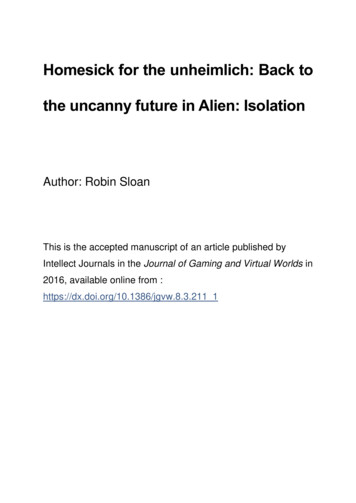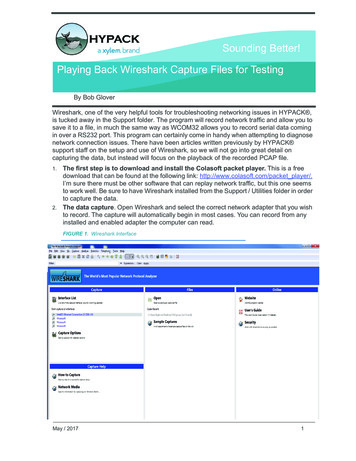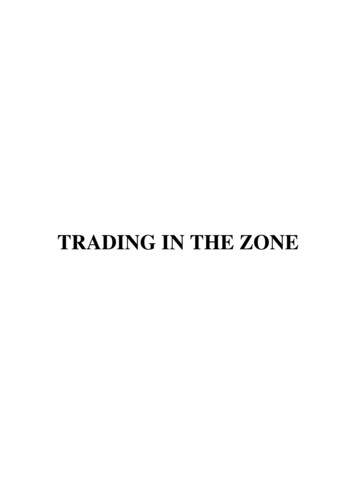
Transcription
Homesick for the unheimlich: Back tothe uncanny future in Alien: IsolationAuthor: Robin SloanThis is the accepted manuscript of an article published byIntellect Journals in the Journal of Gaming and Virtual Worlds in2016, available online from :https://dx.doi.org/10.1386/jgvw.8.3.211 1
Homesick for the unheimlich: Back to the uncanny future in Alien: IsolationRobin Sloan, Abertay UniversityAbstractIn 2014 Sega released Creative Assembly’s Alien: Isolation, a video game sequel to the 1979film Alien. As an attempt to create both an authentic homage to the Alien franchise and acredible successor to Ridley Scott’s original film, Alien: Isolation was received as both awork of remediated nostalgia and as a deeply uncanny survival horror. This article discussesAlien: Isolation framed by theories of the uncanny (the unhomely) and of nostalgia (thehomely), with the aim of revealing how the production design of the game reconciled theseseemingly contradictory but nonetheless overlapping aesthetic qualities. By drawing onexamples from Alien: Isolation’s visual and level design, this article discusses how theintegration of nostalgic and uncanny qualities could be of value to horror and sci-fi gamedesign, in particular to the development of sequels within existing franchises, and toremediations, remakes and reboots.KeywordsNostalgia, uncanny, survival horror, science fiction, production design, level design2
Creative Assembly’s sci-fi survival horror, Alien: Isolation (2014), is predicated on thevirtual reconstruction of a familiar yet unsettling cinematic world. In other words, it is avideo game that is devoted to the dual aesthetics of nostalgia and the uncanny. Within GameStudies this presents us with a particularly interesting case study, as both nostalgia and theuncanny are important concepts to the analysis of video games. The former is of increasingrelevance to the study of retro games, remakes, games history, games culture, and thecollection, curation and preservation of games (e.g. Garda 2013; Heineman 2014; Sloan2015; Suominen 2007; Swalwell 2007; Taylor and Whalen 2008). The latter has been appliedbroadly to studies of horror in games, in particular to the study of survival horror as a subgenre (Kirkland 2009b; Reed 2015; Tinwell et al. 2009), to games that feature uncannyrepresentations such as doubles, ghosts and the undead (Hoeger and Huber 2007; Spittle2011), and to examples of overt simulation and glitches that create unexpected, uncannyexperiences (Brown and Marklund 2015; Holmes 2010).IntroductionFrom the perspective of Game Design, it is valuable to examine how the design anddevelopment process of Alien: Isolation accounted for this duality of uncanny and nostalgicaesthetics. There are clear differences between the warm feelings of nostalgia – which wemight regard as a bittersweet emotion grounded in fond memories of times-gone-by(Wildschut et al. 2006) – and the feelings of anxiety, dread and panic that are associated withuncanny works. But there are also commonalities that could have repercussions on how wedesign and encounter game environments. Not only should we acknowledge that nostalgiaand the uncanny are dichotomous (in reductive terms, they apply to encounters that weperceive to be either homely or unhomely), but we should also consider that they both implythe existence of spatiotemporal discrepancies. On the one hand, nostalgic reconstructions3
play to imperfect memories, selectively presenting us with a remembered (rather thanobjectively accurate) past. On the other hand, the uncanny is experienced when we perceivesubtle inconsistencies that lead us to question the authenticity of our surroundings.Alien: Isolation is a notable example of a sci-fi-themed survival horror video game that aimsto provide players with an experience that is both nostalgic and uncanny. However, it canalso be identified as part of the wider move to produce contemporary video game sequels,remakes, remasters or reboots of well-established sci-fi and horror franchises. This includesongoing sequels and remastered releases within the Resident Evil (Capcom, 1996) and SilentHill (Konami Computer Entertainment Tokyo, 1999) survival horror series, and reboots andremakes of archetypal sci-fi horror video games such as Doom (id Software, 2016) andSystem Shock (System Shock Remastered, 2016). How these video games balance anatmosphere of uncanny dread with potential audience nostalgia should be of interest not onlyto games scholars, but also to Game Developers (particularly to Environment Artists andLevel Designers).The aim of the current article is to analyse the production design of Alien: Isolation in orderto better understand how the developers created virtual spaces that are simultaneouslyuncanny and nostalgic. Specifically, the article sets out to address two questions:1. Is it possible for players to have feelings of nostalgia for an uncanny world, and howcan we understand this seemingly contradictory player experience?2. To what extent does the production design of Alien: Isolation demonstrate successfulintegration of nostalgic and uncanny qualities, and how do these two aestheticqualities interact?In the following sections, I present a case study of Alien: Isolation’s production designframed by the literature on nostalgia, on the uncanny, and on the Alien franchise. I first4
discuss the commonalities between the uncanny and of nostalgia, with a particular focus onVidler’s (1992) discussion of the architectural uncanny. I then briefly discuss the history ofthe Alien franchise, the uncanny qualities of Alien as a work of sci-fi horror, and how thedevelopment, release and reception of Alien: Isolation supports the notion that players canexperience nostalgia for an uncanny world. Finally, I provide an analysis of the productiondesign of Alien: Isolation that considers its spatiotemporal discrepancies and its presentationas a simulation of a period cinematic space.This article is limited in scope in that it specifically investigates the development of onevideo game remediation of an existing cult film. However, it is hoped that this discussion ofnostalgic and uncanny production design in Alien: Isolation will inform the future design andanalysis of game environments that are based on familiar spaces from personal, social orcultural memory.Linking the uncanny and nostalgiaOur experiences of the uncanny and of nostalgia can be related to ideas of familiarity (theunhomely, or the homely) and an orientation towards the past (a past that is either repressed,or remembered fondly). In this section I discuss the underlying literature that links theuncanny and nostalgia, primarily the work of Vidler (1992). The ideas discussed in thissection underpin the subsequent analysis of Alien: Isolation.In his attempt to understand the uncanny as an aesthetic emotion, Freud ([1919] 2003)identified the unheimlich – translating literally as the unhomely – as an appropriate term.Freud was clear that the unhomely was an experience that sat within the parameters of fear:that it ‘belongs to the realm of the frightening, of what evokes fear and dread’ (Freud [1919]5
2003: 123). As Vidler comments, Freud thought that the unheimlich ‘was more than a simplesense of not belonging; it was the fundamental propensity of the familiar to turn on itsowners, suddenly to become defamiliarized, derealized, as if in a dream’ (Vidler 1992: 7). Inthis sense the uncanny can be related to the idea of alienation and our encounters with alienpresences. Freud emphasized, however, that the uncanny does not stem from alienknowledge, but from repressed knowledge: that the uncanny is ‘nothing new or strange, butsomething which was long familiar to the psyche and was estranged from it only throughbeing repressed’ ([1919] 2003: 148). In particular, Freud argued that uncanny is experiencedwhenever we are confronted with unconscious and primitive fears, primarily; fear ofcastration, confrontation with a double, compulsive repetition and animism.In video games, it has been noted that the survival horror genre is invested in the presentationof the Freudian uncanny (Kirkland 2009b; Reed 2015; Tinwell et al. 2009). More than this,the ‘homeliness’ of the environments in the survival horror genre has been stressed. Forinstance, Kirkland (2009a) has pointed out how domestic locations feature prominently as thesets for survival horror games, and that this fits with Freud’s initial definition of the heimlichas ‘belonging to the house’. This stems from the necessity for the Freudian uncanny topresent us with familiar settings and locations, before subverting this familiarity to createunexpected and eerie representations that are unfamiliar to our senses.We can therefore assert that a degree of homeliness is an important trait of the survival horrorvideo game, but this homeliness can often be rudimentary (i.e. basic images andrepresentations of the generic home). While the uncanny concerns unexpected confrontationswith objects that subvert the familiar, nostalgia can be considered a conscious attachment to afamiliar past. Initially identified as a form of chronic homesickness (Davis 1977: 414),nostalgia is better understood today as a longing for the past (Pickering and Keightley 2006:6
920). In contrast to history – which could be described as a means of documenting the pastwith the intention of achieving objectivity – nostalgia, as experienced by individuals andwithin cultures, is less concerned with accuracy or historical ‘truth’. As Erll (2011: 8)explains, ‘memories are not objective images of past perceptions, even less of a past reality.They are subjective, highly selective reconstructions, dependent on the situation in whichthey are recalled’. Starobinski (1966) has postulated that nostalgia arises from what he terms‘memorative signs’: images that trigger our memories for spaces in time, and which incombination facilitate reflection on a past which can no longer be completely restored.Reflection and restoration are key terms for Boym (2001), who puts forward the idea thatnostalgic performance can be categorized as either reflective or reformative. The formeremphasizes the act of remembrance – of dwelling on and longing for the past – while thelatter involves the active reconstruction of the past. These two forms of nostalgicperformance can be related to Baudrillard’s argument that nostalgia is a form of ‘narcissisticregression’ comprised of two parts: a search for origins (reflection) and a search for authenticcraftsmanship (reformation) ([1968] 2005: 80).The interaction between the uncanny, nostalgia, and our interpretation of space has beenexplored in previous work, including studies that have examined cities (Della Dora 2006) andfilm locations (Fiddler 2007). In his seminal work on uncanny architecture, Vidler identifieswhat he terms the ‘traditional links’ between the uncanny and nostalgia (1992: 7), and arguesthat the former is often seen to incite enhanced feelings of the latter (that our feelings ofhomesickness grow in response to an intrusion of the unhomely). Importantly for ourunderstanding of video game spaces, Vidler suggests that uncanny works, includingarchitecture, concern the ‘perpetual exchange between the homely and the unhomely, theimperceptible sliding of coziness into dread’ (1992: 57). It is therefore interesting to consider7
whether the environment design for all survival horror video games can be considered asinterplay between nostalgic and uncanny representations.For Vidler, our orientation towards and understanding of the past provides one importantfoundation for our appreciation of the architectural uncanny. We can think of this as a formof temporal uncanny. On the one hand, we can consider how cultural knowledge gives rise touncanny effects. Vidler is clear that the elements that make up an uncanny space (e.g., theindividual features of a Gothic haunted house) are not in themselves uncanny. Identificationof the uncanny within architecture is reliant upon our understanding of how culturalknowledge can frame perceptions of reality and authenticity. Vidler advises that architecturalattributes will be ‘emblematic of the uncanny, as the cultural signs of estrangement forparticular periods’ (1992: 11). On the other hand, we can think of a temporal uncanny thatemerges from our more intimate knowledge of unhomely houses. Vidler argues that the homeprovides ‘an especially favored site for uncanny disturbances: its apparent domesticity, itsresidue of family history and nostalgia, its role as the last and most intimate shelter of privatecomfort sharpened by contrast the terror of invasion by alien spirits’ (1992: 17). With this inmind, we can see how any example of Boym’s nostalgic reformation can lead to uncannyrepresentations. The act of rebuilding a remembered space is liable to result in environmentsthat fall short of expectations, that mix (intentionally or unintentionally) historical referents,and that blur the lines between our knowledge of the past and our experience of the present.In addition to temporal ambiguities, Vidler discusses how the spatial qualities of architecturecan infer the uncanny. Rather than there being ‘invisible slippages between a sense of thehomely and the unhomely’ (Vidler 1992: 37), the spatial uncanny can instead be identifiedthrough the use of qualities such as repetition, disorientation and claustrophobia. UsingPiranesi’s drawings as an example, Vidler discusses how architectural design can infer8
instability and an ‘endless drive to repeat’ (1992: 38). These spaces can suggest a continualfeeling of movement without progress, or an ‘abyssal drive toward nothingness’ (1992: 38).Quoting Charles Nodier, Vidler recognizes the perceived fragility of Piranesi’s environmentsand the risks that travellers would face if they attempted the climb, only to be presented withan endless repetition of spatial challenges (1992: 39–40
Vidler’s (1992) discussion of the architectural uncanny. I then briefly discuss the history of the Alien franchise, the uncanny qualities of Alien as a work of sci-fi horror, and how the development, release and reception of Alien: Isolation supports the notion that players can experience nostalgia for an uncanny world. Finally, I provide an analysis of the production design of Alien .











